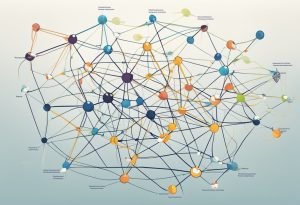ChatGPT NLP is a revolutionary natural language processing technology that has significantly changed how we work with machines. According to OpenAI , ChatGPT is a deep learning, transformer-based model which enables the generation of human text. This means it can produce an answer to a question or a statement that almost indistinguishable from that generated by a human.
ChatGPT NLP, therefore, is a powerful technology that represents the peak of NLP technology, weaving its way through the maze of human language intricacies. It does not just produce answers; it reads, processes, understands, and even creates them to mimic a real conversation. Moreover, as a result of previous interactions, the technology learns the context and can, thus, create accurate responses.
With the already existing applications of the ChatGPT NLP, the technology offers a massive potential that is not quantifiable. Whether it is helping humans with the conversation on customer service or developing unique translation services, whoever put the technology into use could revolutionize the world. Additionally, advancement in the tools used would lead to even more unique applications in future.
Fundamentals of ChatGPT
ChatGPT is a linguistic model by OpenAI that processes natural language into more human-like text. It was built on the transformer architecture, a neural network that has achieved stellar performance in various NLP-related activities. The primary function of ChatGPT is synonymous language output that not only makes sense but fits within context.
Architecture of GPT Models
GPT models build on the transformer architecture, the neural network that the model uses for processing sequential data, that is, natural language text. The transformer is made up of an encoder and a decoder . The encoder processes the input sequence and creates a hidden representation, or context. The decoder crafts the output sequence according to that hidden representation . The model is unidirectional because the decoder has access only to prior tokens in the sequence. This makes the generation coherent and sensitive to the context.
Language Understanding
In general, ChatGPT is pre-trained on a tremendous amount of data and practices to generate language that sounds coherent and relevant to the described context. This process could be divided into supervised and unsupervised learning. The first approach involves training the system based on labeled data, and the second is unlabeled.
ChatGPT NLP uses numerous NLP techniques to understand and generate language. They include tokenization, named entity recognition, sentiment analysis, and part-of-speech tagging.
The model also trains using machine learning algorithms that “play a game” predicting the next word in a sentence given the previous words . To sum up, ChatGPT is an AI language model that leverages transformer architecture and a combination of supervised and unsupervised learning to generate human-like speech. The model is trained on a much data source of text and employs NLP techniques that allow it to generate and comprehend language and making text that is coherent and on-topic in the provided context.
ChatGPT Training and Fine-Tuning
As mentioned above, ChatGPT is retraining a model. In other words, ChatGPT was trained on a tremendous amount of text data – a corpus of several terabytes. Still, to apply ChatGPT to narrow use case, it should be retrained on a small example text dataset. Such an example is called fine-tuning. Fine-tuning involves training the model on a small dataset to make the model learn specific features of the text and problem to be solved.
Supervised Learning Techniques
As for supervised learning, it is also frequently used to fine-tune a model. During the training, supervised learning is a type of learning when a model is trained on a dataset that consists of input and output pairs. In this case, input acts as textual data, and output as the provided response. The goal of the training is to obtain a model that can predict output given input. Thus, to fine-tune ChatGPT using supervised learning, the dataset that consists of input-output specific task pairs is created . The model trained on this dataset is made using a supervised learning algorithm, which modifies the model’s parameters to reduce the difference in the predicted and actual output.
Reinforcement Learning from Human Feedback (RLHF)
Another approach that can be used to improve ChatGPT is reinforcement learning from human feedback . As the name implies, RLHF involves training the ChatGPT model with a rewarding system. In other words, the model generates a response, which is subjected to human judgment. This human then rewards the ChatGPT algorithm based on how close the model is to the appropriate conclusion.
In order to properly fine-tune ChatGPT with RLHF, the model must be first pre-trained on a large corpus of text data. Following this, the model is used to generate responses to a specific task, which are then evaluated by humans alongside their reward signal as a form of feedback . Afterward, the model is updated to maximize its reward signal .
In essence, fine-tuning is a critical step in enabling ChatGPT’s use for specific tasks.
Through fine-tuning the model with a task-specific dataset, AI can learn task-specific patterns and enhance its performance. Supervised learning and RLHF nevertheless are two main approaches to use in order to fine-tune ChatGPT with both their set of unique advantages and disadvantages.
Applications of ChatGPT
ChatGPT is an effective NLP model that has been utilized in a variety of contexts. Client help Robotization and Content Creation and The board are two of ChatGPT’s most extensively used applications that will be analyzed in this part.
Customer Service Automation
One of the most widespread applications of ChatGPT is customer service automation. It is possible to develop chatbots using ChatGPT technology, which will help interact with customers in real-time and manage their questions or concerns . They could be supported on the company’s websites, mobile applications, and social media environments, allowing companies to provide twenty-four-hour customer service.
ChatGPT-based chatbots efficiently manage such queries as a description of the product, the status of the order, or billing inquiries. Additionally, they could provide targeting and general recommendations to frequently encountered dilemmas.
Content Creation and Management
Content creation and management: ChatGPT can be used to create and manage content. Businesses can apply it to generate content quickly while maintaining high quality. This tool enables businesses to train the model on a particular subject or industry. This ensures that the content is relevant .
Additionally, ChatGPT can be applied in content management by automatically tagging and categorizing content. This assists businesses in arranging their content and makes it easier to access . It also summarises the long content making it easy to understand and read. To sum up, ChatGPT is a general NLP model that can be applied in different ways. Due to its ability to read and write texts in human-like language it is achievable that ChatGPT will find application in areas like customer-service automation, as well as create and manage content.
Challenges and Ethical Considerations
Natural Language Processing has seen significant improvements in recent years. From the introduction of large models such as ChatGPT, which can generate text output that appears to be written by a human in reaction to textual input, to its recent use in almost all context types and formats. NLP has become more convenient and immediately capable for any user to consume. Aware of the nature of technology and Artificial Intelligence as a whole, it is also essential to recognize some of the use-cases and challenges to NLP users. The following section identifies some of the most critical ethical considerations and challenges to ChatGPT.
Bias and Fairness
The most significant regarding this AI system is bias related to the outcomes of the model. Bias can take several different forms, depending on how it arises. Several potential sources of bias in the ChatGPT could be related to data when the model was training, or its design. For example, when the training data for the model contains bias, the outputs would also contain such bias . When the design is inherently structured to support one response over another, outcomes can be biased.
To combat these issues, researchers are developing methods to identify and reduce biases in NLP models such as established AI language models like ChatGPT. Several methods are proposed to form those such as adversarial training. Using adversarial training, for example, the model is trained to generate responses which are resistant to attempts to inject bias . Another solution is data augmentation that allows generating more diversified training data which in turn provides training data with more views.
Privacy and Security
The other major issue with ChatGPT is the risk of privacy and security issues. As ChatGPT can generate outputs to text inputs, it can expose users to the risk of having their information disclosed . For instance, if a user inputs personal information into a chatbot built with ChatGPT services, then the information is stored in servers, hackers could target the information.
Fortunately, researchers are working on developing ways to respond to these risks. The simplest approach is to use techniques like differential privacy, which involves adding noise to the model’s response to prevent specialized responses. Another option is to use secure multi-party computation solutions, which will allow even if the user base of the model is compromised.
Generally, ChatGPT has the potential to transform NLP to a new level; it is essential for the scientific community to pay attention to the ethical paradigm and the challenges implementing this technology. It is vital to address all these risks to promote a responsible and ethical use of ChatGPT.



